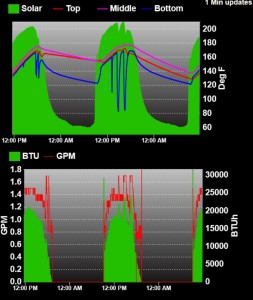Variable Speed Pumps (cont.)
[UPDATE: see the article Variable Speed Pumping, posted on 4/16/2014 for a more detailed discussion on actual commercial systems.]
Here’s the continuation of my recent conversation with Rod Hyatt…
“Variable pump speed control alone I can improve the performance of a collector 20 to 30%. That is a huge jump in performance. Note, I’m tracking the solar BTU, pump speed and tank temperatures. Note the red line on the bottom graph as the pump speed changes to milk more heat transfer out of the collectors. If I programmed the controller to on/off pump operations only, you’ll see the pump short cycle dreamily in the early and late part of the day. It just can’t synchronize to the Btu that are being created as the sun arches through the sky and clouds. For this data logger, when I disable the variable pump speed control, It records a loss of about 25% of the solar energy. Without it, you would need to add 25% more panels to meet the same output. I have measured FP and VT, performance improvement is excellent on both on Drainback or pressurized. The attached is monitoring vacuum tube collectors on a drainback arrangement.
Also noteworthy, notice the blue line showing the temperature of the bottom of the tank. Each time water is drawn out, cold water fills the area of the heat exchanger and the Delta T changes. You can see the pump speed react and it’s measurement for the Btu’s being collected also jumps. You’ll also notice that the pumps starts once and stops at the end of the day. Days with full sun, the pump never cycles.”
– Rod Hyatt
Rod,
Your reservoir holds the collector loop fluid with an exchanger in the water heater and a single pump. I also presume you are using a TACO variable speed pump in the 00 family.
I am still examining the benefits of a variable speed collector pump and your data lends credence to the idea. However, our system has some characteristics that make the use of variable speed pumps more difficult. We put all water cooled collector pumps inside our thermal cavity, where the heat from the pump goes into the tank water. We cannot put a variable speed pump with built-in controller because the temp could kill the circuit. I haven’t yet searched for components to mate a variable speed control with a delta T controller.
On our bigger systems with external collector pumps, we would also need separate components that do delta T control and variable speed control. If you know of such units, let me know.
[UPDATE 1-5-15: See the article above for an explanation of how these problems were solved. ]
We put the solar heat into the CW line going to the water heater/boiler. I have used recirc systems many times, but only when the solar tank and water heater are pretty far apart. I find the single pass system is simpler and less expensive. The solar tank is usually much more efficient in holding the solar energy than a boiler’s hot water storage tank.
Even when the solar heat is over 50%, I never refer to the solar as primary, only supplemental. This may be just semantics, but since the solar is not reliable in the short run, and a full power conventional system is always required, I call the solar supplemental. I don’t mind supplementing 90% or 100% of the conventional energy in the summer.
Regards,
Dr. Ben

